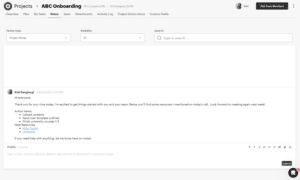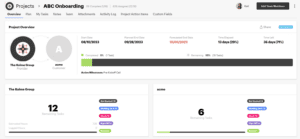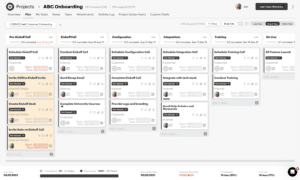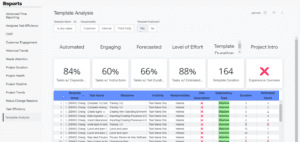Executive Summary
For those well-versed in the customer onboarding realm, navigating the intricacies of the process is a familiar challenge. From setting clear expectations to providing unwavering support, onboarding is a complex part of the customer journey.
Surprisingly, there are striking similarities between onboarding and project management, and leveraging these shared principles can lead to remarkable outcomes. Project management’s role in customer onboarding is indispensable, ensuring a seamless and successful experience. With its emphasis on planning, organizing, and execution, project management brings a wealth of best practices and adaptable frameworks to the table.
In this blog post, we’ll delve into the synergistic relationship between these two disciplines, unveiling how their collaboration fuels the path to customer success.
Empowering Customers for Success
Defining Customer Onboarding
Customer onboarding is the process by which a business helps a customer get started with their product or service.
The goal of onboarding is to provide customers with the information, guidance, and support they need to achieve success and get the most value out of the product or service in a quick amount of time.
Effective onboarding involves educating customers on features and capabilities, outlining steps needing to get started and addressing any questions or concerns along the way.
The onboarding process typically includes a series of calls that act as tutorials, providing training and other resources to help the customer feel supported and set up for success.
Why is Customer Onboarding Important?
When it comes to building a successful business, one of the most important things you can do is focus on providing your customers with an exceptional experience. And while there are many ways to achieve this, one of the most critical aspects of any customer relationship is the onboarding process. When successfully onboarded, customers are less likely to encounter problems and more likely to adopt your product or service.
Customer onboarding can significantly impact a business’s bottom line by increasing revenue and customer retention.
Pretty important, right?
So, let’s talk about how you can ensure you’re delivering the best onboarding experience possible through project management.
The Importance of Project Management in Customer Onboarding
Project management plays a significant role in ensuring a successful customer onboarding process. A poorly executed onboarding process can lead to customer frustration and confusion, leading to a negative impression of the business and a lack of usage or adoption of your product or service. By utilizing principles of project management, businesses can develop a structured, methodical approach to their customer onboarding process, resulting in a more efficient and effective experience for customers.
Key Benefits of Using Project Management Principles in Onboarding:
- Establishes clear goals and expectations: Project management requires clearly defined goals and objectives, which are essential for the successful execution of a project. This principle applies equally to customer onboarding. The onboarding phase of the journey allows the customer and the onboarding consultant the opportunity to discuss objectives and goals. Understanding what the customer wants to achieve and what success looks like for them helps you tailor your project plan to their needs and kickoff in the right direction.
- Develops a Plan of Action: Project management can help businesses develop and implement a plan that outlines the tasks, roles, responsibilities, deadlines, and resources needed for each phase of the onboarding process. Project management tools can make this process easy and scalable as you start to take on more onboarding projects. Project tasks are assigned to the right person at the right time, and with deadlines, everyone knows when deliverables are expected of them. With a clear plan of action in place, businesses can better prepare for and manage customer expectations, avoid delays, and ensure a smooth onboarding process.
- Increased Efficiency: Project Management can improve the overall efficiency of the onboarding process. By clearly defining the project scope, stakeholders, timelines, and milestones, project management can help businesses identify potential bottlenecks or areas where the process can be streamlined.
GUIDEcx has a nifty reporting feature that provides insight into which tasks take the longest to complete or are most often marked as “stuck.” Through these real-time insights, you can start to adjust your templates and see results with any new projects you take on.
- Builds strong relationships: Onboarding presents a remarkable opportunity to foster meaningful connections with your customers. Establishing strong relationships built on mutual trust and understanding is paramount, especially in the context of smooth project management. By empathetically grasping your customer’s needs and aspirations, you can sow the seeds of trust from the outset. Embracing transparency, clarity, and open communication, project managers should set clear objectives, milestones, and timelines right from the start. In case of any shifts in circumstances, forthrightness is key – keeping clients informed nurtures trust. To delve deeper into the significance of trust in project management, don’t miss Kim Essendrup’s enlightening TEDTalk, titled “Trust Bricks.” Embrace the power of trust-building and propel your projects towards success.
- Establishes effective communication channels: Effective communication is vital for the success of any project, and customer onboarding is no exception. Setting up a regular forum for open communication means you are better equipped for problem-solving and updating your customers and stakeholders throughout the project lifecycle. Project management tools help create a space for communication and provide regular project status updates. This provides an opportunity to make any necessary changes before the project goes off track. This can give the clients comfort that they are on the right path and work to continue maintaining trust.
- Increased Customer Satisfaction: Ultimately, effective project management can play a crucial role in driving customer satisfaction. The implementation of project management principles in onboarding ensures that resources are used effectively and productivity is optimized. When customers feel that the onboarding process is well-organized, efficient, and supportive, they are likelier to use a company’s products or services. This, in turn, can lead to increased loyalty, referrals, and revenue. There’s nothing quite like that happy feeling you get when completing an onboarding project, and the customer still wants to work with you simply because they enjoy it. Efficient Delivery and solutions focused can fuel long-term customer relationships.
Now that we know some of the advantages of using project management principles in onboarding let’s look at some practical steps you can start taking to include them in your onboarding process.
Practical Steps for Effective Project Management in Customer Onboarding
1. Define Project Scope and Goals from the Beginning:
As most onboarding projects are just getting started, they will typically encompass some sort of “Kickoff” milestone or phase. For example, sales will close the sale, and an onboarding project will be generated. Step 1 for the onboarding consultant will be hosting a Kickoff Call with the customer. Kickoff calls are an essential step. Kickoff calls will normally involve various stakeholders, including the customer and any team members involved in the project. The call will include introductions, a review of scope and objectives, timelines and milestones, and an overview of expectations.
I recommend working together with your customers to define specific outcomes for onboarding. Some common outcomes include team training, product knowledge, technical configuration, or tech stack integrations. Next, spend a lot of time strategizing – A clear understanding of goals and expectations ensures that you and the customer are on the same page from the get-go. Nothing is worse than delivering a project that does not match the customer’s expected outcomes. Defining the project scope and goals can help all parties stay aligned and ensure everyone is working towards the same desired outcome.
2. Develop a Detailed Onboarding Plan of Action:
Once your project scope and goals are defined, you have to decide how you’re going to reach success. In my past experiences, onboarding action items were often laid out within tools such as a slide deck, meeting agenda or email – but how consistent, actionable or trackable is that? Onboarding projects would fall behind, and various consultants would implement things differently, which meant a lack of consistency, impacting the customer experience. Customers don’t want to play consultant roulette and end up with a lousy experience. Effective customer onboarding requires a plan of action that lays out specific steps that must be taken by each party to achieve success. Project management tools, like GUIDEcx, can help you scale your onboarding process by developing a repeatable onboarding plan of action that is accessible to all necessary parties throughout onboarding. It will include a timeline, assign timely tasks to responsible parties, and keep everyone on track through weekly project updates. Their project templates are fully customizable, so you can be as detailed as you want with your plan and task instructions. Typically, the clearer and more concise you are with your plan of action, the more likely your customers are to complete their assigned tasks without a hitch. Even without a project management tool, you’ll want to be sure to develop some sort of checklist of tasks that need to be completed, owners for each, and timelines for completion.

GUIDEcx Project Notes
3. Set Up a Tracking System:
Using a project management tool can help immensely with this step. You’ll want to be sure to keep onboarding statuses up to date and ensure that all team members and stakeholders have real-time visibility into project progress.
Cloud-based programs are awesome for this very reason – there’s no more emailing of static information that’s outdated by the time it reaches someone’s inbox.
A tracking system can help gauge if the project is on target, help understand if key objectives are achieved, keep stakeholders informed, and manage risks.
- Projects in GUIDEcx have an overview page, which does a great job of showing the current status of a project.
- There’s a “start date,” “end date,” and “forecasted end date.” The forecasted end date will fluctuate in real-time and depends on how quickly tasks are completed. This prevents any surprises along the way and allows you to mitigate new problems in real-time.
- GUIDEcx also offers a breakdown of task responsibility – seeing which tasks are handled by your internal team and which are handled by the customer. This can help communicate the level of value you bring to the table for the customers coming in.

GUIDEcx Project Overview
4. Communicate Clearly and Regularly:
Just as with any relationship, effective communication is key. Setting up regular check-ins or syncs can help keep stakeholders engaged and informed. It can also help propel the project forward by maintaining momentum.
If you’re suffering from meeting fatigue, sometimes weekly email updates can suffice, assuming no major hiccups need to be addressed in person. Regular communication can help you identify any challenges or delays so that you can take corrective action sooner rather than later.
With GUIDEcx, project updates are sent out weekly in one consolidated email, showing the progress of any projects you may have your hand in.
Another common space for communication in GUIDEcx is the project notes area.
- Here, you can easily post things like call recaps and updates.
- Using mentions, you can easily @customer to notify all customers on the project, @internal to update all internal members on the project, or simply @mention a particular person by name. It’s a slick function that helps keep those communication lines open while also saving time.
- But what if you have a note that you’d like only internal team members to see? Don’t worry – you can do that, too, through internal-only notes.
Additionally, using a tool such as GUIDEcx allows you to invite numerous team members to the project for free as an observer or contributor. An example would be inviting the sales team responsible for closing the sale and the customer success manager (CSM) who will take the torch once onboarding is complete. This allows for added visibility and cross-departmental communication, eliminating the silos you may typically see in companies.

GUIDEcx Project Plan
5. Use Technology to Streamline and Automate:
I’m sure you’ve noticed by now that I’ve mentioned the use of project management tools quite a few times. If you’re not using them, you’re missing out on serious productivity and efficiency. Automation and technology can play a significant role in streamlining the customer onboarding process. For instance, auto-sending a welcome email rather than typing one up manually each time. Scheduling tools are another one of my favorite pieces of technology. It’s so much easier to send a link to a calendar that updates with your real time availability rather than sending emails back and forth about timeslots you may or may not have open at any given time. I’m sure we’ve all fallen victim to a good game of email tag. If you want to get real fancy and level up some more, try integrating your scheduling platform with your project management tool, and watch the wheels of automation start turning (Pssst…we help with integrations here at Kolme too!).

GUIDEcx Template Analysis Report
6. Evaluate and Refine:
Once the project has ended, it’s essential to:
- Evaluate your results
- Identify areas of improvement
- Refine your process as you continue to grow
While utilizing project management principles in customer onboarding will often lead to happier customers, there’s also going to be some who will provide feedback on how to improve things. Consider using their input in your future iterations of your onboarding projects, even creating a backlog to review later.
If you’re looking for simple ways to collect feedback or measure satisfaction, GUIDEcx has a CSAT feature that you can turn on at either the milestone or project completion level. If collecting at the milestone level, you can then pinpoint which details need reworked in your project template.
GUIDEcx also has a variety of reports providing data and insights into which tasks are causing bottlenecks, which projects are healthy, and which need attention, the level of customer engagement on your projects, and so much more. These native reports allow for educated decisions when making any template or process adjustments – no more throwing spaghetti at the wall and seeing what sticks.
Conclusion
Project management and customer onboarding are two interrelated practices. Project management principles can significantly improve customer onboarding processes and can help take things to the next level for your business and the customer experience.
Imagine a world with smoother onboarding, greater efficiency, and increased customer satisfaction. By defining the project goals, developing a detailed plan of action items, setting up a means of tracking progress, communicating effectively, using technology to streamline workflows, and continuously iterating and improving your process, you can begin managing a customer onboarding program that promotes success for all.
I promise your customers (and employees) will thank you. If you’re interested in taking your onboarding process up a notch, contact us here at Kolme to see how we can help.

